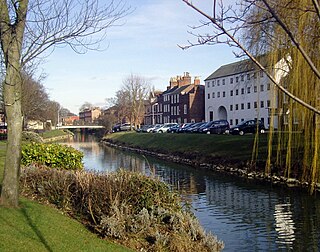
Spalding is a market town on the River Welland in the South Holland district of Lincolnshire, England. The main town had a population of 30,556 at the 2021 census. The town is the administrative centre of the South Holland District. The town is located between the cities of Peterborough and Lincoln.
The West Bridgford School is a co-educational comprehensive school with academy status in West Bridgford, Nottinghamshire, England.
Lincolnshire is one of the few counties within the UK that still uses the eleven-plus to decide who may attend grammar school, in common with Buckinghamshire and Kent. As a result, many towns in Lincolnshire have both a grammar school and a secondary modern school.

Spalding Grammar School (SGS), fully known as The Queen Elizabeth Royal Free Grammar School Spalding, is an 11–18 boys' grammar school in Spalding, Lincolnshire, England. By November 2015, a total of 985 boys were enrolled at the school, 277 of which were enrolled on 16 to 19 study programmes.
Spalding High School (SHS) is a grammar school for girls and a mixed sixth form located in Spalding, Lincolnshire, England.

St Ambrose College is an 11–18 Christian Brothers' Roman Catholic boys' grammar school in Hale Barns, Altrincham, Greater Manchester, England. It was founded in 1946 by Joseph Robertson. In 2012 the school became an academy, and was completely re-built. Upon leaving the college, boys are referred to as ‘Old Ambrosians’ and many go on to join the Old Boys' Association.

Hayesfield Girls' School is an all-girls secondary school with a co-educational sixth form located in Bath, England. In August 2011, the school became an academy. The school operates from two main sites, about a seven-minute walk apart. The campus at Brougham Hayes accommodates STEM subjects such as Science, Technology and Maths, and the Upper Oldfield Park campus hosts the Performing Arts, English and Sports faculties.
Landau Forte Academy QEMS is an 11–16 secondary school with academy status located to the north of Tamworth, a market town in Staffordshire in the Midlands north of Birmingham. It is often known simply as QEMS . Since 1 September 2011, the school has been owned and operated by the Landau Forte Charitable Trust, after being transferred from the Staffordshire LA control.

Gleed Boys' School was a secondary school for boys aged 11 to 16, in Spalding, Lincolnshire, England.

Notre Dame Catholic Academy is a Catholic secondary school and sixth form in Everton, Liverpool, England. Founded by the Sisters of Notre Dame de Namur, it was a girls' school for most of its history but became coeducational from September 2012. From June 2024, the school joined St Joseph’s Catholic Multi Academy Trust, becoming Notre Dame Catholic Academy.
Carlton Bolling is a co-educational secondary school, located in Bradford in West Yorkshire, England. It has more than 1,400 pupils.
The Clere School is a small co-educational community secondary school in Burghclere. Although its postcode locates to Reading via Newbury, it is in Hampshire, England. The current Headteacher is Rob Milner, who has held the position since January 2023. The school caters for academic years 7 to 11, but does not have a Sixth Form.

Cowley International College, formerly Cowley Language College and originally Cowley School, is an 11-18 secondary school located on Cowley Hill, in Windle, St Helens, Merseyside.

Longton High School was a school in Longton and later Meir, Staffordshire from 1760 to 2010.
University Academy Holbeach is a co-educational secondary school and sixth form located in Holbeach, Lincolnshire, England.
Spalding Academy, formerly Sir John Gleed School, is a mixed secondary school and sixth form in Spalding, Lincolnshire, England.
University Academy Long Sutton is a co-educational secondary school located in Long Sutton in the English county of Lincolnshire. The school educates pupils from the local surrounding areas in Lincolnshire, and a little from Cambridgeshire and Norfolk

Cowley Academy is a mixed secondary school with Academy status, in Donington, Lincolnshire, England. As of 1 September 2022, it is part of the South Lincolnshire Academy Trust.
Education in Nottingham is governed by the unitary authority of Nottingham, overseen by its Nottingham City Council.









